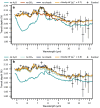Sulfur dioxide in the mid-infrared transmission spectrum of WASP-39b
- PMID: 38232945
- PMCID: PMC10901732
- DOI: 10.1038/s41586-024-07040-9
Sulfur dioxide in the mid-infrared transmission spectrum of WASP-39b
Abstract
The recent inference of sulfur dioxide (SO2) in the atmosphere of the hot (approximately 1,100 K), Saturn-mass exoplanet WASP-39b from near-infrared JWST observations1-3 suggests that photochemistry is a key process in high-temperature exoplanet atmospheres4. This is because of the low (<1 ppb) abundance of SO2 under thermochemical equilibrium compared with that produced from the photochemistry of H2O and H2S (1-10 ppm)4-9. However, the SO2 inference was made from a single, small molecular feature in the transmission spectrum of WASP-39b at 4.05 μm and, therefore, the detection of other SO2 absorption bands at different wavelengths is needed to better constrain the SO2 abundance. Here we report the detection of SO2 spectral features at 7.7 and 8.5 μm in the 5-12-μm transmission spectrum of WASP-39b measured by the JWST Mid-Infrared Instrument (MIRI) Low Resolution Spectrometer (LRS)10. Our observations suggest an abundance of SO2 of 0.5-25 ppm (1σ range), consistent with previous findings4. As well as SO2, we find broad water-vapour absorption features, as well as an unexplained decrease in the transit depth at wavelengths longer than 10 μm. Fitting the spectrum with a grid of atmospheric forward models, we derive an atmospheric heavy-element content (metallicity) for WASP-39b of approximately 7.1-8.0 times solar and demonstrate that photochemistry shapes the spectra of WASP-39b across a broad wavelength range.
© 2024. The Author(s).
Conflict of interest statement
The authors declare no competing interests.
Figures








References
-
- Zahnle, K., Marley, M. S., Freedman, R. S., Lodders, K. & Fortney, J. J. Atmospheric sulfur photochemistry on hot Jupiters. Astrophys. J.701, L20–L24 (2009).10.1088/0004-637X/701/1/L20 - DOI

